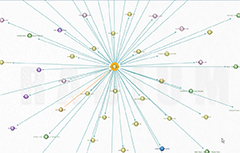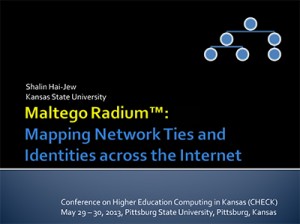
“Network science” has come to the Web and Internet! Various software tools enable the extraction and visualization of social media platform data, as well as technical Internet network information. One of the foremost tools is Maltego Radium (by Paterva).
“Using Maltego Radium to Map Network Ties and Identities Across the Internet” will be presented 2-4 p.m. Friday, Nov. 8, at 301 Hale Library for any who are interested.
Mapping network ties
Maltego Radium (version 3.3.3) is a penetration testing tool that may be used to collect public data from the Surface Web about organizations, websites, and human identities. Among other things, this software tool may be used to:
- Map the electronic domains in a physical geographical location
- Identify locations of servers for companies or organizations
- Connect individuals to their email accounts
- Disambiguate aliases by connecting them to personally identifiable information (PII)
- Monitor “conversations” on microblogging sites (like Twitter)
- Identify ad hoc networks that have emerged around particular events
- Map connections to an Internet Protocol address
- Identify device types used on a network
- Connect organizations and individuals to each other
These abilities foster awareness of social and technological presences and interrelationships across the Internet. This application will be showcased as a white-hat research tool to increase “knowability.” (This software tool has a black-hat side, especially when it’s mixed with other software tools, knowledge, and capabilities.)
The tool’s interface is highly usable and interactive. The visual outputs are interactive and include half-a-dozen graph visualizations in a social network (node-link) format. The tool also outputs full-length reports.
Presentation agenda
In the first hour, this presentation will focus on the basics of electronic social network analysis and some of the capabilities of the tool. There will be light discussion about how this information may be used in research.
The second hour will focus on a variety of digital crawls, namely how to conduct “machines” and “transforms” of a target, and how to visually map and analyze the data.
 (An earlier and shorter version of this presentation was first given at the Conference on Higher Education Computing in Kansas (CHECK) at Pittsburg State University in Pittsburg, Kan. The Shockwave Flash-based slideshow from that presentation is available at “Maltego Radium(TM): Mapping Network Ties and Identities across the Internet.”)
(An earlier and shorter version of this presentation was first given at the Conference on Higher Education Computing in Kansas (CHECK) at Pittsburg State University in Pittsburg, Kan. The Shockwave Flash-based slideshow from that presentation is available at “Maltego Radium(TM): Mapping Network Ties and Identities across the Internet.”)
Any who are interested may attend. Feel free to bring questions and ideas. No prior knowledge is needed. A free (limited) community version of Maltego Radium is available for short-term use. For more information, please call Shalin Hai-Jew at 785-532-5262.